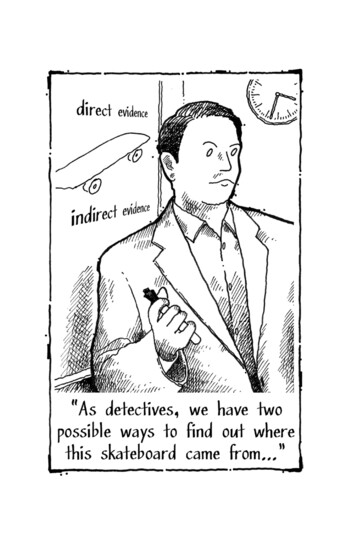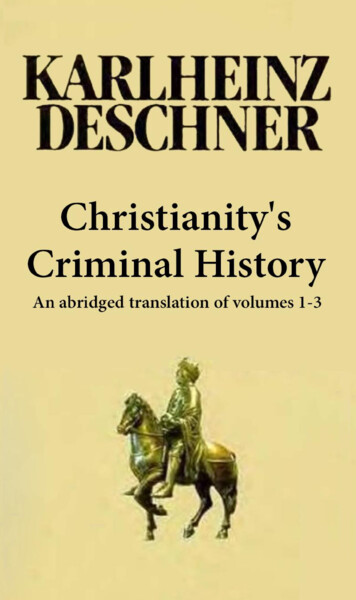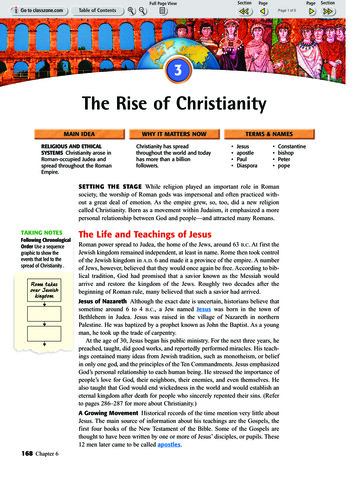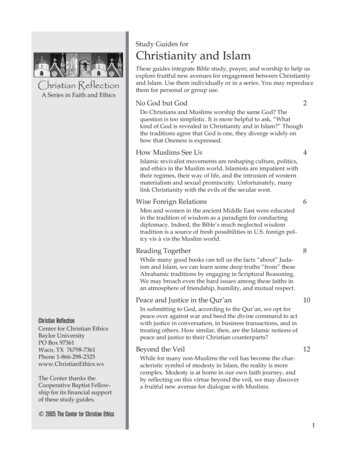
Transcription
During the week, you find yourself thinking“big” thoughts—thoughts about God andwhether He is real. You wonder if Jeffries mightbe able to help answer your questions, but whenyou meet the following Tuesday, he’s more interested in the skateboard.“As detectives,” he booms out in his big voice, “we have twopossible ways to find out where this skateboard came from. First,we could try to find a witness who was there when the skateboard was placed in the shed. Witness evidence is called ‘directevidence.’”
COLD-CASE CHRISTIANITY FOR KIDS42DetectiveDefinitions“What if there wasn’t a witness?”you ask.Jeffries smiles like he’s glad toDirect/Indirect Evidence:Sometimes we are luckyenough to have a witness who can help usunderstand what happened in the past. Butwhat do we do whenthere isn’t a witnessavailable to us? We relyon “indirect” evidence.hear the question. “Then we’ll haveAll kinds of things canbe used as evidence tomake a case, so takesome time to thinkcarefully about all theother facts you mightbe overlooking.we were able to figure out the skate-to use ‘indirect evidence.’ We alsocall this ‘circumstantial evidence.’”“I think I’ve heard about that.It’s not as good as a witness, right?”asks Hannah.“Not true,” Jeffries replies. “Wedidn’t have a witness last week, butboard was old! We used circumstantialevidence. The skateboard’s location,the sticker, the cobwebs—that wasall circumstantial evidence.”Jeffries looks at Daniel. “I askedDaniel to do some investigating forme this week.”“Yes sir,” replies Daniel, standing to his feet. “I went to GreatSkates, our only local shop for skateboards. The owner, Mr.Martin, says these are large, seventy-five-millimeter wheels, usedfor speed.“He’s the only guy who sold skateboards with these wheelsten years ago—and they’re not made anymore.” Daniel sits backdown.
Chapter 3: Think Circumstantially“Good work, Daniel,” Jeffries sayswhile nodding. “So now we have evenmore indirect or circumstantial evidencethat the skateboard is old. By the way,I was in the crime lab all day, with nowindows. But I knew it was rainingoutside. How? One of my assistantscame in; I knew she had just arrived,and I saw big drops of water on her coatand hair. If she had simply told me itwas raining, I would have known aboutthe rain from the direct evidence of her43CSIAssignmentJesus also wants usto collect the evidence.Read John 10:25.What kind of evidencedid Jesus say would“testify” about Him?Read Acts 1:2–3. Jesusstayed with His disciplesfor forty days afterthe resurrection andprovided them with many.
COLD-CASE CHRISTIANITY FOR KIDS44statement. But I didn’t need her to say a thing. The indirect evidence of the water drops and her wet hair was more than enough.See the difference?” asks Jeffries, scanning the cadets for responses.You speak up: “Can we talk a little more about the Jesus case?I was thinking about God and miracles this week. It seems to methat if God is real, then miracles can happen. I get that. But howare we supposed to collect evidence about God—even indirectevidence? He’s invisible!”Jeffries smiles at you and you see his top row ofteeth, which aren’t exactly straight. But still, hesmiled! He replies, “This is a perfect examplefor this week’s lesson. Indirect evidence can bepowerful, and we do have indirect evidence forGod. A lot of it, actually.”Everyone is paying attention now. “Where?” asks Daniel.“What kind of indirect evidence?”Jeffries walks up to the whiteboard. “Let’s make a circumstantialevidence diagram as we list the evidence for God.” He starts todraw.You lean over and whisper to Daniel and say, “I didn’t realizedetectives have to be artists.”Jeffries overhears you, smiles, and jokes, “Better to be an artistthan a con artist!” Everyone laughs. Jeffries continues drawing andsays, “This won’t be difficult to sketch out.”“First, we’re in a universe that began to exist, just like we talkedabout before. What made it begin? Whatever it is, it would have to be
Chapter 3: Think Circumstantially45something outside of space, time, and matter. We know that God fitsthat description.”Jeffries draws a set of falling dominoes on the board as a symbol ofa universe that “starts” to exist (like a row of dominoes that start to fallwhen the first one is pushed).He continues, “Next, scientiststell us that the universe is incrediblyfine-tuned for the existence of life.The laws of nature and physics areamazingly delicate. Scientists haveno idea why this is the case, unless ofcourse, the universe was designed fora purpose: to be the home for humanbeings like you and me. It seemsreasonable that God would design inthis way if He created us like a lov-DetectiveDefinitionsCon artist:Someone who gains thetrust (or confidence) ofanother in order to lie ortake advantage of them.Some people think thedisciples of Jesus werecon artists, but is this areasonable conclusion?ing Father.” Jeffries draws a designer’scompass on the board as a symbol of the fine-tuning of the universe.
46COLD-CASE CHRISTIANITY FOR KIDSThere’s more. “Scientists also see signs of design in biology.Your body is incredibly designed, and you even have informationin your body called ‘DNA.’” Jeffries draws a DNA molecule:“The DNA molecule is an instruction manual for your body.It contains more information than all the books in your schoollibrary, and information is a sure sign of intelligence.” Jeffriespicks up the skateboard. On the bottom of the board, he finds asmall stamped set of words:
Chapter 3: Think Circumstantially“Take a look at these three words,”he says, showing them to the cadets.“How do you think they got here?”Hannah quickly raises her hand.“That’s easy. Someone put them there;probably the company that made theboard.”“Couldn’t they have just landedhere by accident?” asks Jeffries.“It doesn’t seem likely,” answersHannah.“I agree,” replies the detective. “Infact, information like this sentencealways comes from intelligence. Youcan’t get this simple sentence from47DetectiveDefinitionsInformation:A series of symbols, objects,or letters that describe aspecific idea or request.The information in this book,for example, is written witha series of letters in a specific order. The informationin DNA is written with aseries of “nucleotides” thatare also in a specific order.The information in thisbook (like all information) isthe result of an intelligentsource (the author). Butwho is the intelligent authorof the information in DNA?
COLD-CASE CHRISTIANITY FOR KIDS48chance or the laws of physics. When you see information, youknow it was caused by intelligence; in this case, the people whomade this board.”He points to the DNA molecule on the whiteboard. “Theinformation in this molecule is billions of times more complexthan that sentence on the bottom of the skateboard. Whatevercreated the information in DNA would have to be a lot smarter.If there is a God, He would be the most intelligent Being ever,right? He could easily create the information and design we see inour DNA,” Jeffries says as he draws a microscope as a symbol ofthe design we see in biology.He sees the cadets and some look like they are ready to headout for the day. But he motions their attention back to him. “Onemore thought for today: As a police officer, I know it’s never okayto steal something for the fun of it. Where does that kind ofmoral truth come from? Is it just a matter of opinion? Does itcome from the state where we live?”
Chapter 3: Think Circumstantially“Yes, I think so,” answers Hannah.Jeffries asks another question: “Whatif the state didn’t have a law about stealing? Would that make it okay to steal?”The cadets talk about it, and theyagree it wouldn’t be okay to steal, even ifthere weren’t a law against it.“All right then,” continues Jeffries,“the truth about stealing seems to comefrom something other than my personalopinion or the state where I work. It’sbigger than all of us. God is also biggerthan all of us, so God is the betterexplanation for the source of truthabout stealing.” He draws two tabletson the whiteboard symbolizing the TenCommandments of God.49A“Tool”forYourDetective Bag!CircumstantialEvidenceRemember that nearlyeverything can be usedas evidence. There aremany ways to build acase for God’s existenceand many kinds ofevidence you can useto discover the truthabout God. Look closelyat the world around youto find more evidence ofGod’s existence.
50COLD-CASE CHRISTIANITY FOR KIDSDetective Jeffries’s diagram is now complete:“Take a look at this circumstantial case for God. Four verydifferent pieces of evidence all point to the same conclusion. Godis the best explanation for all this evidence.”The cadets look around at one another and consider whatDetective Jeffries has just said.
44 COLD-CASE CHRISTIANITY FOR KIDS statement. But I didn’t need her to say a thing. The indirect evi-dence










